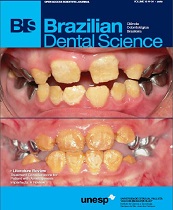In vitro evaluation of marginal leakage at enamel and dentin treated by different laser densities
DOI:
https://doi.org/10.14295/bds.2013.v16i4.924Resumo
Objectives: To evaluate “in vitro” the degree of marginal leakage in class V cavities irradiated with Nd:YAG laser onto enamel and dentin pretreated with bonding system (Single Bond, 3M ESPE) without light-curing. Material & Methods: Class V cavities were performed and standardized in 60 bovine incisors. After the acid etching, the teeth were divided into three groups: G1 – Application of bonding system, irradiation with Nd:YAG laser at 140 mJ/pulse without light-curing. G2 – Application of bonding system, irradiation with Nd:YAG laser at 200 mJ/pulse without light-curing. Group C - Application of bonding system and light-curing. Next, resin composite restorations were executed and thermocycled at alternated baths from 2 to 50 ºC (± 2 ºC), totalizing 500 cycles. To assess the microleakage, the teeth were submersed into 50% silver nitrate solution for 24 h, cut at 1 mm of thickness and analyzed through stereoscopy. The following leakage criterion scores were employed: 0 – none leakage; 1 – gingival or incisal wall; 2 – axial wall towards the pulp. Results : It was observed a high leakage frequency with score 1 among the experimental conditions. There was a higher predominance of score 2 leakage for control group at cementum. Concerning to enamel and cementum, Group C was similar to G1. By comparing control group with G2, and G1 with G2, it was verified statistically significant differences. Conclusion: The laser energy provided a reduction of the marginal leakage at enamel and dentin/ cementum; however, the energy density increase resulted in smaller marginal leakage at enamel and dentin/cementum.
Keywords
Nd-YAG Laser; Energy; Marginal leakage; Enamel; Dentin.
Downloads
Downloads
Publicado
Como Citar
Edição
Seção
Licença
TRANSFERÊNCIA DE DIREITOS AUTORAIS E DECLARAÇÃO DE RESPONSABILIDADE
Toda a propriedade de direitos autorais do artigo "____________________________________________________________________" é transferido do autor(es) para a CIÊNCIA ODONTOLÓGICA BRASILEIRA, no caso do trabalho ser publicado. O artigo não foi publicado em outro lugar e não foi submetido simultaneamente para publicação em outra revista.
Vimos por meio deste, atestar que trabalho é original e não apresenta dados manipulados, fraude ou plágio. Fizemos contribuição científica significativa para o estudo e estamos cientes dos dados apresentados e de acordo com a versão final do artigo. Assumimos total responsabilidade pelos aspectos éticos do estudo.
Este texto deve ser impresso e assinado por todos os autores. A versão digitalizada deverá ser apresentada como arquivo suplementar durante o processo de submissão.




























